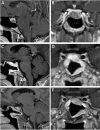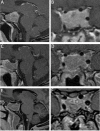Surgery for acromegaly: Indications and goals
- PMID: 35992136
- PMCID: PMC9386525
- DOI: 10.3389/fendo.2022.924589
Surgery for acromegaly: Indications and goals
Abstract
Acromegaly is a disease that occurs secondary to high levels of GH, most often from a hormone-secreting pituitary adenoma, with multisystem adverse effects. Diagnosis includes serum GH and IGF-1 levels, and obtaining an MRI pituitary protocol to assess for a functional pituitary adenoma. Attempted gross total resection of the GH-secreting adenoma is the gold standard in treatment for patients with acromegaly for a goal of biochemical remission. Medical and radiation therapies are available when patients do not achieve biochemical cure after surgical therapy.
Keywords: acromegaly; adenoma; endonasal; endoscopic; pituitary; skull-base; transnasal.
Copyright © 2022 Bray, Mannam, Rindler, Quillin and Oyesiku.
Conflict of interest statement
The authors declare that the research was conducted in the absence of any commercial or financial relationships that could be construed as a potential conflict of interest.
Figures




References
Publication types
MeSH terms
Grants and funding
LinkOut - more resources
Full Text Sources
Medical
Miscellaneous

